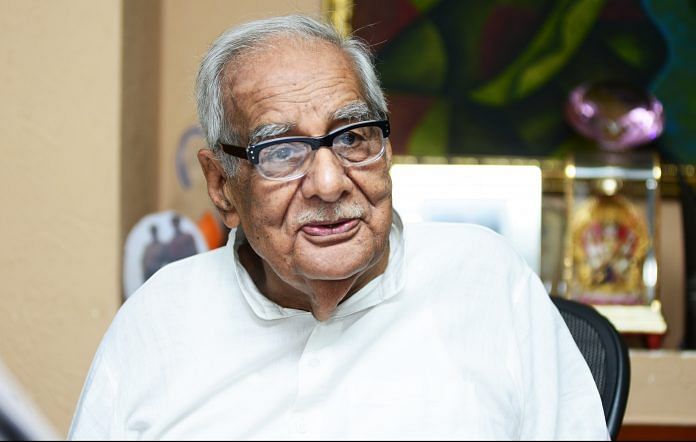Perhaps, someone will now institute a much-needed Kuldip Nayar Peace Prize.
One of my father’s closest friends from the pre-Partition days, Kuldip Nayar was someone I have seen, had glimpses of and read my entire life. I remember his tall, gangly, rumpled figure, slightly awkward gait, and that wonderful thicker-than-lassi Punjabi accent from childhood. He started each sentence with his very memorable “Suno…” or with “Look here ….” But I got to know him better when I wanted to be a journalist and The Indian Express had just opened in Chandigarh. I had joined journalism classes in Chandigarh University — but did not really care for the formulaic training and preferred to learn on the job. With a bit of Punjabi nepotism, as the editor of the paper at the time, ‘Uncle’ gave me a break as a trainee reporter. We had a wonderful team there, which included Shekhar Gupta and others. I have fond memories of a very relaxed Kuldip Nayar giving us a lot of leeway to grow and learn.
I also interacted with him when he was working on one of his many books and wanted someone to research for him. Once again, I had a very laid back author, who seemed content with what I sifted out — without really feeling the pressure. Kuldip Nayar wore many hats, and all of them very comfortably. I used to wonder how from the downside of being a persona non grata during the Emergency when he was jailed, he got his career going again to become the High Commissioner in the UK. This was of course highly unusual for a journalist. But this was his secret — despite the scoops he churned out, he managed to keep all his friends, or at least he did not allow them to go too far.
Then, recently, we met again when we were setting up the Partition Museum in Amritsar — and he immediately said he would be a patron. This was despite the fact that his wife Bharti Nayar, of whom I am also exceedingly fond of, had all kinds of worries about it. The distance of years meant nothing, because the Partition was still very close to him, as he narrated the story of how he left Sialkot and the difficult journey to re-settle his life once again. For years he was haunted by that border, which for him was a meaningless line. That interview with him now plays in the Museum daily and has been viewed by lakhs of people.
Also read: ‘Looking Back’: Filling in the gaps of Partition
Till ill health prevented him, he would go to the Wagah border and light candles there every year, with friends coming from the other side of the border. It had become an annual ritual. This was a space in which the Partition Museum fitted into beautifully, as it is also about hope and reconciliation. But for him, these were also all a paean to the past — about a life when religion did not matter.
With his typical helpfulness, Nayar would give me names and numbers of people to contact — as he still believed in the old Punjabi biradari of working together. We were fortunate that somehow our struggle bore fruit and the Partition Museum is now well established. I remember last year I had wished we had the funds to name a Peace Prize after him, and I had shared the idea with him wondering how to take it forward. We wanted to give it from the Partition Museum team.
Perhaps someone will now institute a Kuldip Nayar Peace Prize — which is much needed. But of course, the first recipient should have been him, in his lifetime.
Kishwar Desai is a former journalist and founder of the Partition Museum in Amritsar.




Rest in Peace My Brother from across the Border.
We shall meet again.
Great idea to establish a peace prize in his name.
Kuldip Nayyar represents those Pakistan born refugees who had the emotional attachment to their birthplace, in his case sialkot and made emotional attempts on India Pakistan relations. Like Manmohan Singh his efforts came to naught as the Pakistani Army does not have an emotional bond like Mr. Nayyars or MMSs. Their feeble attempts at rapprochement looked like a personal desire without the benefit of geopolitical realities.
Shri Kuldip Nayar recounted how the last meal he had before being jailed during the emergency was a good breakfast ordered for him by the police officer in charge, from Ashoka Hotel. Had enough respect for the discernment of his readers to leave something for them to discover Between the lines. Rest in peace.